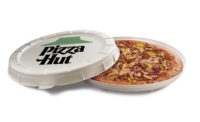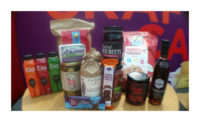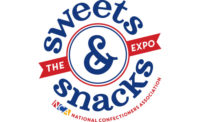2022 PREDICTIONS | PACKAGING
Three Top Trends from an Expert Packaging Designer
Tom Newmaster shares thoughts on what retail packaging may look like in the coming year and beyond

PHOTO CREDIT: Aja Koska / Getty Images

Easy Does It. TEAPIGS United States takes a minimalist approach to packaging and standing out on shelf.
PHOTO COURTESY OF: TEAPIGS United States

Bargains by the Bundle. Ramar Foods created its own eCommerce site, “Crave Filipino,” and offers three distinct bundles of popular products for shipping.
PHOTO COURTESY OF: Ramar Foods

To reflect the brand's move to a modern, premium cookie, Famous Amos, Ferrara added a contemporary, refined look to packaging with location-inspired graphics meant to “invite the consumer into another world of flavor.” A new resealable stand-up package also locks in freshness.
PHOTO COURTESY OF: Ferrara / Ferrero Group




Discussing packaging trends is something akin to talking about reincarnation—where something is reborn, reborn and reborn yet again. When it comes to packaging however, each new iteration brings more sophistication and promise.
Many of us in packaging look forward to 2022 and an eventual end to the pandemic. We look forward to a period with full retail store shelves and we expect brands to discover new and profitable ways to make friends with the earth.
Meanwhile, we need to add a healthy degree of realism. In that spirit, let’s look at three much-touted trends.
1. Is less more, or is less less?
The concept behind the move toward minimalist packaging is simple: in a retail environment, where everything on the shelf is screaming for your attention, it’s the laid-back package that sticks out
Minimalist design also has other inherent advantages; it looks classy, “with it” (think Apple’s “White Album”-style boxes), and proponents claim it’s more eco-friendly (since it can involve less labeling and other add-on materials). Such benefits are rumored to be the secret of its great appeal. But does it pull?
My research partner put minimalist packaging to the test with consumers. The findings do not exactly align with the enthusiasm of the design community.
My opinion? Apple had it right, but keep in mind it’s not just the plain white box. Rather, it’s the rich quality of the materials that say, “This is Apple” . . . and it fits everything about the brand promise.
Another example of a brand getting it right with simplicity, is MF People, a line of personal care products. The minimalist design deletes extraneous noise, so the brand’s cross-gender appeal becomes self-evident.
The moral of the story? Minimalism is cool if you’ve got the product message and materials to make it work. Otherwise, it’s just designers talking to each other. Or, as one industry expert says in this article, “…minimalism can be useful in clarifying a product’s unique selling points, but poorly thought-out minimalism can simultaneously slip into bland branding – or “blanding.”
2. Bundling: A joy when it comes to eCommerce
Amazon offers a wonderful opportunity for brands to sell bundled products and actually increase sales for their brands. Everyone who buys on the platform knows this line, “Frequently bought together.”
Amazon’s algorithm will assemble a bundle of products for you. A recent piece in Selling notes that “Bundles must consist of items that are highly complementary. When a brand offers unique bundles, the results are a win-win for the brand and the consumer. Bundles are a great way to pair up several lower-priced items and actually turn a profit. Because the FBA fee is only deducted from one item, rather than each individual item.” So, you make higher margins.
The key for designers is to ensure that your product packaging literally lends itself to bundling. In other words, products should look like they fit together. Knowing the e-commerce world is essential to success.
3. The luxurious brand extension
Everyone talks about product line extensions but this is especially important for legacy brands that had relevance to earlier generations. Let’s look at Famous Amos. They were saved from bankruptcy in 1996 when Kellogg bought them. Yet they’ve always been perceived as a single-serve, pick-up item for a convenience store.
Ferrero International purchased Famous Amos in 2019. And more recently, brand managers took an interesting approach to refreshing their positioning—by going premium. The mission was to reinvigorate brand identity, reconnect with consumers and attract new ones. Ferrero gave Famous Amos a reboot by repackaging and launching three varieties with premium ingredients such as coconut, hazelnut and white chocolate. Look for other brands to use this same premium upgrade in the near future.
My opinion involves a note of caution. If your brand has too many extensions, they tend to blend together on shelf and lose their differentiation. Make sure each extension is distinct enough to communicate a new experience to the consumer.
The elephant in the room
Supply chain challenges will continue to beleaguer us. This becomes more and more evident the closer we get to 2022.
Some observers suggest that the CPG branded business model is partly to blame. A recent report in Vox news media claimed the packaging industry’s “just-in-time” model has contributed to its current woes. Factors cited include how brands typically have a “hair-trigger, on-demand” operating style. The result is that we are now on the precipice of significant shortages.
As they put it in Vox, “These issues have now reached a critical mass. So even though American consumers have started to order much more stuff, there’s no flexibility in the supply chain to accommodate that demand.”
Tom Newmaster has 30+ years of experience in CPG branding and package design. From 1998 to 2016, he led creative and won awards for The Hershey Company, Pfizer, Stoner Car Care and Zippo. He has launched new products for Fresh Solutions Network, Koch’s Turkey, Klamath Basin Fresh Organics and Wolfgang Candy to name a few. In 2017, Tom started FORCEpkg and since then has become a leading voice in the packaging industry and has written for top trade and mainstream business publications. To learn more about FORCEpkg, visit www.forcepkg.com.
Looking for a reprint of this article?
From high-res PDFs to custom plaques, order your copy today!









